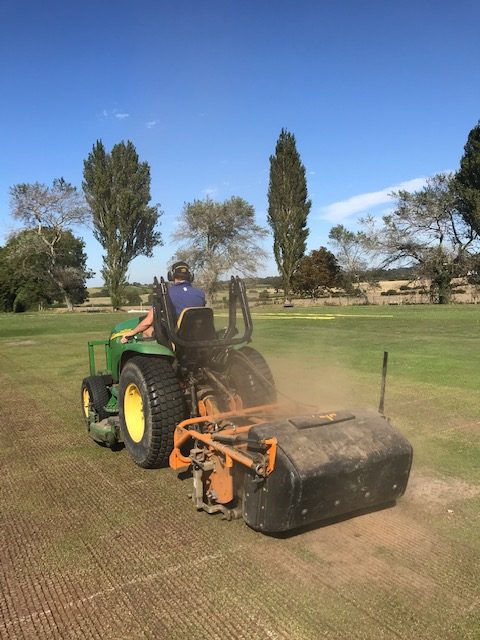This blog is my own opinion of 5 reasons why you need to renovate your cricket square.
What may need to be done
1. Unused wickets created more thatch (dead grass) than possibly used wickets.
2 . Used net wickets or match wickets (said in hope) will need renovations.
3. We have a poa (annual meadow grass) problem to control.
4. With inputs in square watering and fertilising the plant will be growing, and producing litter (dead leaf) and will later turn into thatch.
5. We need to consider the years of previous renovations investments and the need to protect the investment.
What needs to be done and why unpacked
1. Unused wickets, without the process of cutting, raking, brushing and play will naturally build litter, that will turn into thatch over the coming winter.
When you verticut, do you remember seeing all that brown rubbish (dead leaf’s). Well as l am sure you are aware as hard as we worked at verticutting, we will not remove all that rubbish with verticutting alone.
Whether we use the wicket or not the grass plant is a living thing and is shedding leaf’s at a regular intervals. All these dead leaves need removing via some form of scarification or thatch will build.
Scarification will also help remove any ageing or weak ryegrass plants and pull out a good percentage of shallow rooted poa.

THATCH is said to be the number one killer of a cricket pitches potential performance.
2. Used wickets that are either used for grass nets or matches (hopeful thinking) will need some level of renovating as in previous years.
Why do we need to renovate wickets, well l call it the three Rs.
Remove(scarifying), removal of dead grass and poa (weed grass) that’s builds up cricket or not!
Reseed, this is vital with the purpose of regaining a rye grass canopy, that will out compete the poa.
Suggested seed rates a min of 50-70grams a square metre or 100 grams a square metre on bare soil.
Restore, unless your left with a completely level surface after games/nets then some form of top dressing will need to be applied.
If the ends are less deep or you have used less wickets, obviously you need less loam.
If your square is completely unused you will probably only need a light coating of loam, to cover the seed and to infill any surface damage after scarifying (4/6 bags a strip).
Top dressing lightly, you will lose progress though on building up of low areas that you have on your square, but for one year this isn’t a major issue.
Where can you reduce costs – loam is the most likely option in terms of level end restoring.
Reducing seed is NOT an option l would look at in terms of saving money, reducing seed rates is a false economy as it is so vital in preventing weeds, moss and weed grass.
3. Poa (annual meadow grass) has had the year of its life, last year’s renovations where a wash out for many and poa filled in the gaps in the sward.
Poa had a wet winter, which yet again encouraged it further and then an early season drought, in which it could flower and spread its seed further.
If we now give it a low-key scarification, we are certainly losing more ground to weed grass, a weed grass that has a major effect on pitch performance, not to mention its thatch building qualities.

Renovations always need to be aggressive in nature in the form of scarification, our worst scenario is top dressing loam onto a canopy of grass, which will create a buried layer of grass and can be very costly to remove.
4. This is not that case at every club, but with volunteer groundsman having more time and possible a willing team of helpers, water and fertiliser inputs have been higher in 2020 than this time last year.
This is great and so encouraging to see, but we also have to be aware with grass growth, the increase in poa and the general build up in thatch.
5. If your club is anything like mine, we have invested thousands in end of season renovations over the years to keep pitches performing well, via the action of the three Rs (remove-reseed-restore). i.e. we need to protect our environment.
5 reasons why you need to renovate your cricket square, as l hope you can see if hopefully gaining some merit with you, and please read on for more information.
Available Options
1. Doing nothing is an option, but has to be the last result in my opinions for the reasons above.
2. Unused squares, a lighter renovation is an option but a light renovation could well end up storing up more costly problems and l can only see potential issues, so l really don’t recommend it.
3. Used squares even if only half used will need renovating, but some wickets may have a higher level of the three Rs than others.
Conclusion
My aim will be to renovate as each pitch requires, but aggressive scarification is a must across all options. In my opinion a no renovation policy is out of the question, l can only hope l am supported in this view from my own club.
Treasurers may ask surely why can we not skip renovation just this year?
My answer is to this is poa, it has had the year of its life and do we really have the means to hit the square soo much harder next year, when the poa is even stronger after another winter.
keep an eye out also for the Grounds Management Association , who will release there own guidance very soon.
I hope your enjoyed my 5 reasons why you need to renovate your cricket square.
Brian
Any of your own views or comments, please feel free to leave in the replies box below.
Please note the views and opinions of our bloggers are just that and for professional advice get in touch with The Grounds Management Association through there regional pitch advisers.Brian and team
For more cricket specific blogs, check out our cricket section- https://turfcareblog.com/cricket/ and check out our blog on poa as mentioned so much in this blog –https://turfcareblog.com/how-to-control-and-prevent-annual-meadow-grass/



1 comment
Great summary, thank you